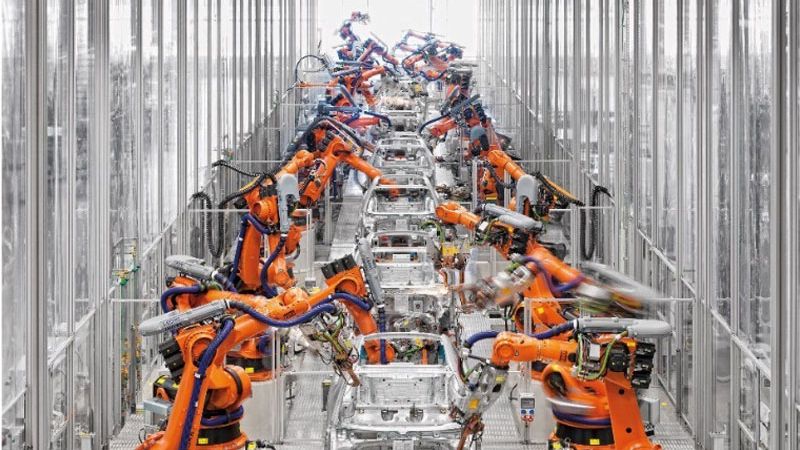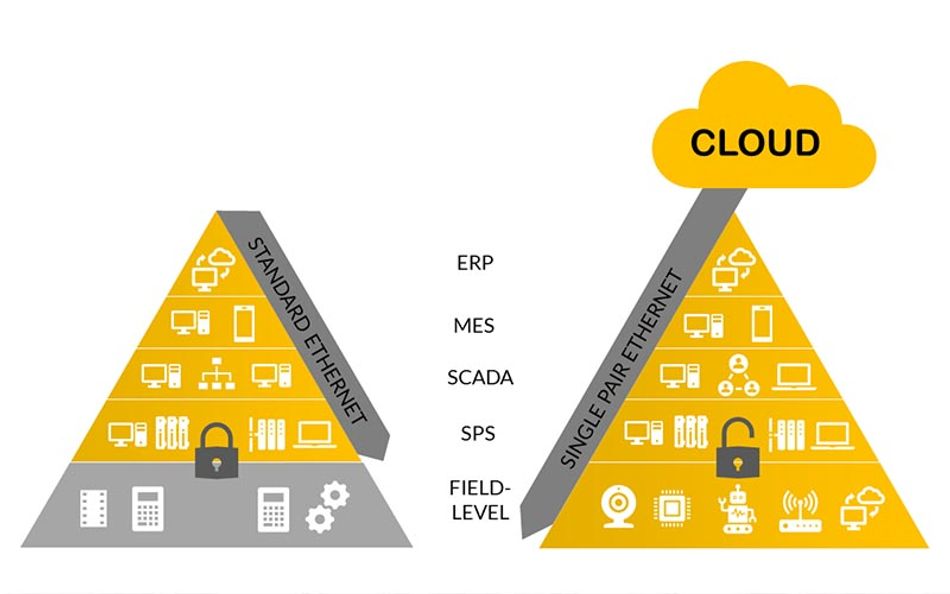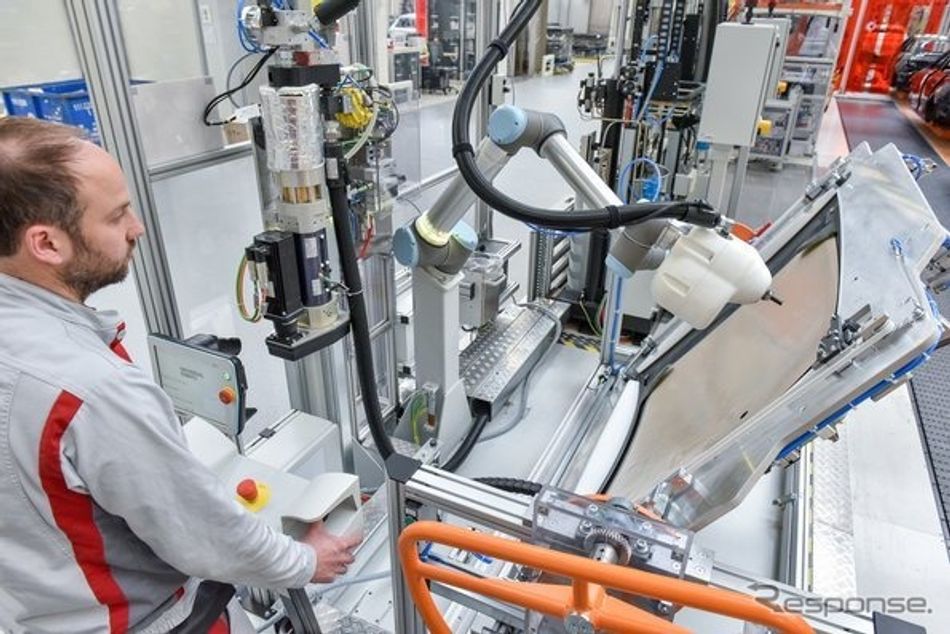SPE Delivers on the Promise of IIoT
Article 2 of our SPE series: Fulfilling the potential of the Industrial Internet of Things (IIoT) requires a standardized communication approach that Single Pair Ethernet can deliver.

KUKA
This is the second of three articles exploring the topic of Single Pair Ethernet (SPE). This first article introduced SPE and its varied applications. This second article will discuss the role of SPE in Industrie 4.0 and the Industrial Internet of Things. The final article will showcase case studies where SPE is making an impact in streamlining wired communication.
Introduction
Industrie 4.0 or the Fourth Industrial Revolution are the terms given for the current shift in the organization and control of the industrial value chain. Manufacturing is moving away from a fixed, linear system of mass production to a highly agile, responsive, and customizable system of production that uses automation and data to build efficiency.
One of the key pillars of Industrie 4.0 is the advent of the Industrial Internet of Things (IIoT). IIoT is a network of intelligent devices, via networks linked to databases, which monitors, collects, exchanges, and analyzes data. IIoT utilizes the power of smart machines and real-time analysis to create useful opportunities for the data within industrial settings by connecting data gathering and analyzing points. This connected network paves the way for seamless automation, precise and predictive maintenance, and highly customizable production through informed data decision making.
While most of the technical and theoretical framework exists to move industry of all sizes into the IIoT paradigm, there are still some challenges that exist before this occurs. Among the most significant of these is the need for highly reliable communication and cabling technology.
Single Pair Ethernet, a physical layer networking technology that uses just a single pair of twisted copper wire - in contrast to two or four pairs of conventional Ethernet - is the communication technology that can take IIoT to its next level.
A Deeper look at IIoT
There are several key differences between the Internet of Things (IoT) and IIoT that highlight why it needs a specific tailored response. While IoT uses the ubiquity of wireless networks to connect everything from smart globes to your vacuum cleaner, IIoT must use other forms of communication networks to be able to deliver fully reliable, secure, and standardized functions.
A successful IIoT system is made up of several necessary factors:
Intelligent equipment that can measure and store information about itself and its environment and communicate that data.
A data communication structure.
Intelligent applications that create useful information from raw data and utilize it to optimize processes.
Interface and analysis tools that provide opportunity to utilize the information for qualified decision-making.
The connected equipment, which in an industrial setting may range from sensor-equipped sorting areas to cobot actuators, sends information directly to the IIoT infrastructure, where it is transformed into useful information on the status or performance of a machine, a group of machines, or of the whole plant. The information can then be used to optimize production and supply processes as well as foresee maintenance. The glue that holds this system together is the method in which this data is sent.
Why IIoT needs SPE
For IIoT to fulfil its potential, data must be able to be transferred quickly, reliably, and consistently across the network. Currently, this is often a complicated, expensive, and equipment-intensive problem. A manufacturing facility may use different types of protocols for varying equipment pieces which results in isolated and fragmented field devices without a means for true networked communication. As manufacturing facilities move towards automation, it is essential that field devices and other data points can be managed remotely from the cloud.
Connection from cloud to field level
SPE provides the chance to truly connect from the cloud down to the smallest sensor. Currently, Ethernet is used at the control level of a manufacturing network system but then alternative technologies are used to connect sensors and actuators because Ethernet has been too costly and bulky to insert at the field level - meaning there is a break between the Ethernet-based control level and the field level. In most cases, fieldbus systems or even analogue systems are still used in this final stage. SPE would prevent the need for this break as well as provide a variety of other advantages by seamlessly connecting field level devices to the control level.

Cost-effective installation
Physical communication layers can present a large upfront cost that is prohibitive to change. However, the transition to SPE is much more cost-effective than other physical networking layers for several reasons. First, it is a much more lightweight system than 2 or 4 pair twisted wire systems. This reduced weight also a reduces cost. Secondly, transitioning field level devices to SPE is fast and cost-effective by using a media converter between the existing Ethernet level and the new SPE to field level. Once field level applications are connected with SPE they can be easily configured and monitored remotely. The wide-adoption of SPE protocol across a production facility offers higher functionality, and flexibility thanks to unified connection technologies for cables & connectors.
Speed
With just a single pair of twisted wires, SPE can deliver speeds up to 1 GBit/s. Previously, this required two pairs for Fast Ethernet (100MB) and four pairs for Gigabit Ethernet. Speed is integral to a functional IIoT system because its success is ultimately tied to how quickly it can communicate with other IIoT devices, to feed data to applications for interpretation and use. In the opposite to field busses or analogue networks, SPE is able to use the Time Sensitive Network (TSN) Ethernet layer, to communicate in realtime. This isn’t just fast, it enables the common and uniform ethernet protocol for safety-relevant applications.
Standardization
Standardization is an essential element for the rollout of SPE throughout industry. Users of all sizes must be able to confidently invest in efficient network and cabling structures based on standardized interfaces that can future-proof their enterprises. The IEC standardization committee SC 48B published IEC 63171-6 as an international standard for Ethernet interfaces using only single pair wires in January this year. The standard describes the T1 Industrial Style mating face, standardized by HARTING in 2016, as the internationally standardized default interface for SPE networks in industrial M3I3C3E3 environments.
This first internationally recognized standard will be one of many as SPE technologies become proven and agreed upon by stakeholders across the field.
Simultaneous power supply and data
In addition to data transmission via Ethernet, SPE also enables a simultaneous power supply via PoDL - Power over Data Line. In the past, PoDL (Called PoE – Power over Ethernet in 4/8-pair Ethernet) required either two pairs of wire for Fast Ethernet (100MB) or four pairs for Gigabit Ethernet.
PoDL means machines, robotics, and other equipment can experience simultaneous power supply and data to devices with only one connection. PoDL with SPE means factories and production lines can lean into the flexibility promised by Industrie 4.0. PoDL is especially useful for the integration of collaborative robots or cobots into workplaces. These robots which are designed to work closely with humans can offer a means to add automation elements into manufacturing facilities incrementally and with enormous flexibility.

Challenges and collaborations
SPE for industrial applications is rich with potential. Its success will rely on intelligent collaboration between major stakeholders across the Industrie 4.0 and IIoT ecosystems. This means communication and vision-sharing between all players from the regulation level down to the factory floor.
The SPE Industrial Partner Network
A global partner network of both cable and chipset manufacturers as well as OEMs have made a united commitment to Single Pair Ethernet. This network will work together to ensure that SPE technology is pushed further and faster by striving for collaborative innovation. Partnerships within the network will allow for increases in product and performance variations as well as smoother standardization processes. The founding members of the SPE Industrial Partner Network include HARTING, TE Connectivity, HIROSE, Würth Elektronik, LEONI, Murrelektronik, and Softing IT Networks. Currently, the network has grown up to 35 member companies and is increasing weekly.
The network is founded as an association in German law. So every member has to commit to the IEC 63171-6 standard and to the common goal, to set a complete SPE Ecosystem.
Conclusion
Manufacturing is on the edge of a major transformation that will affect not only large production facilities but factories and plants of all sizes. For automation and smart manufacturing to truly become a reality a single, high-performance wired communication infrastructure is essential. SPE is this infrastructure. With wide, ambitious global collaboration SPE can unlock the potential of IIoT and be a major driver of the next manufacturing revolution.
About the Sponsor: SPE Industrial Partner Network
The SPE Industrial Partner Network is the assurance of quality for uniform and coordinated infrastructure that meets set standards. The network represents stakeholders from all aspects of SPE technology. It is committed to spreading knowledge about the potential and development of SPE. You can join the SPE Pioneer Summit 2020 in November as well via this link.
Interested in learning more? You can join the SPE Pioneer Summit 2020 in November as well via this link.

